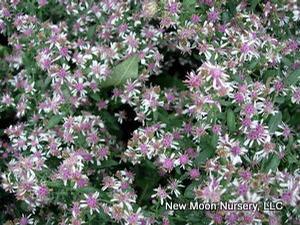New Moon Nurseries

Calico aster can be used for rain gardens, bird and butterfly gardens, and for restoration and conservation.
Aster lateriflorus 'Lady in Black'
Calico aster
Native to North America (cultivar)
FIRST IMPRESSIONS: Aster lateriflorus ‘Lady in Black’ is a shrubby aster with dark stems and plum tinged leaves. In late summer plants produce myriads of starry pinkish daisies with rosy centers. The flowers are prominent against the dark leaves and stems. Plants are tough and adaptable prospering in sun or part shade and in dry or average soils.
HABITAT & HARDINESS: Aster lateriflorus occurs from Canada through the central and eastern United States. The species is often a woodland aster and is indigenous to wet meadows, bottomland forests, seeps and disturbed moist depressions.
This is a Dutch selection of our native Aster lateriflorus.
Plants are hardy from USDA Zones 3-8.
PLANT DESCRIPTION: Aster lateriflorus ‘Lady in Black’ has striking vertical stems that branch densely as they heighten. Plants form colonies from underground rhizomes and also have a tendency to self-seed.
Purple oval leaves form at ground level and smaller purplish leaves are arranged on the upper portions of the black wiry stems.
Flower sprays materialize in late summer and continue until mid-fall. Individual heads are composed of a ring of pale pink petal-like ray flowers surrounding a central cluster of rose colored disc flowers. Blossoms are produced in profusion and are frequented by bees and butterflies.
Plants grow 3-4’ tall with 3’ spread.
CULTURAL & MAINTENANCE NEEDS: Aster lateriflorus ‘Lady in Black’ flourishes in sun or part shade. In shade, however, plants are more open and airy with fewer flowers and less intense purple leaves.
Plants adapt to most soil types. They tolerate drought and leaves are somewhat unpalatable to deer and rabbits.
This center of this vigorous plant may decline if the crown is not divided every few years. Division can be performed in early spring or in fall as plants go dormant.
LANDSCAPE USES: This is a good choice for a Wildlife Garden or Meadow. Plants are also used as a Butterfly Nectar Plant, Butterfly Host Plant, Cut Flower or as part of a Grouping or Mass Planting. Aster lateriflorus ‘Lady in Black’ has Showy Blooms and is appropriate for Cottage Gardens, Deer Resistant Plantings, Water-wise Landscapes, Low Maintenance Plantings, Perennial Borders and Shade Gardens.
COMPANION & UNDERSTUDY PLANTS: Try pairing Aster lateriflorus ‘Lady in Black’ with Echinacea purpurea ‘Ruby Star’, Echinacea tennesseensis ‘Rocky Top’, Rudbeckia subtomentosa, Liatris spicata, or Panicum virgatum ‘Rotstrahlbusch’.
Aster pilosus is similar in appearance and could work in sunny dry sites if a substitute is needed. Penstemon digitalis ‘Husker Red’ would provide similar purple foliage and white flower colors.
TRIVIA: Many of the established Latin names of Aster spp. were changed recently due to DNA and genetic research findings. So Aster lateriflorus ‘Lady in Black’ is now known as Symphyotrichum lateriflorum ‘Lady in Black’.
Plants host caterpillars of the Pearl Crescent and Checkerspot Butterflies.
The Chicago Botanic Garden’s Plant Evaluation Program conducted a comparative study of 119 different asters. Aster lateriflorus ‘Lady in Black’ was one of 7 asters that received the highest rating. According to the study, “Top rated asters displayed consistently strong habits, superior flower production, excellent disease resistance and full winter hardiness throughout a six-year evaluation term.”
Height:
3-4 ftSpread:
3 ftSpacing:
3-5 ftUSDA Hardiness Zone:
3-8Bloom Color:
WhiteAster lateriflorus 'Lady in Black' Characteristics
Attracts Wildlife
- Pollinators
- Butterflies
Attributes
- Cut Flower
- Coastal
- Clay Soil
- Rock Garden
- Dried Flower
Exposure
- Full Sun to Partial Shade
Deer Resistant
- Deer Resistant
Flowering Months
- October
- September
Foliage Color
- Purple
Growth Rate
- Fast
Juglans nigra Tolerance (Black Walnut)
- Yes
Salt Tolerance
- Medium
Season of Interest (Foliage)
- Fall
- Summer
- Spring
Soil Moisture Preference
- Dry
- Moist
Interesting Notes:
AKA Symphyotrichum lateriflorum 'Lady in Black'